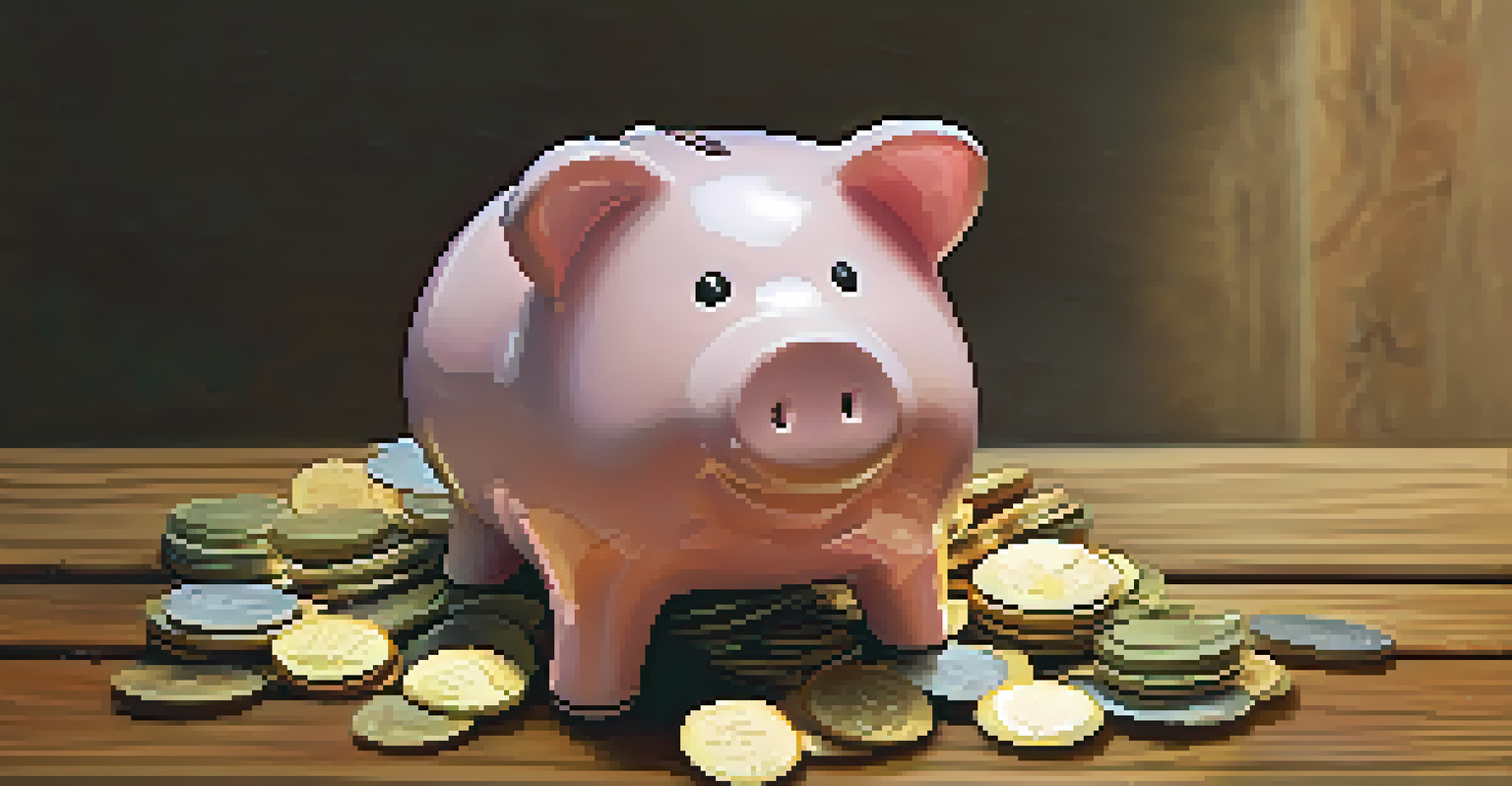Emergency Funds: A Strategy for Financial Stability

Understanding Emergency Funds and Their Importance
An emergency fund acts as a financial safety net, designed to cover unexpected expenses such as medical bills or car repairs. Having this fund means you're not forced to rely on credit cards or loans during tough times, which can lead to debt accumulation. It provides peace of mind, allowing you to navigate financial bumps in the road with confidence.
An investment in knowledge pays the best interest.
Imagine facing an unexpected job loss or a sudden home repair without an emergency fund—stressful, right? An adequately funded emergency reserve can help you weather these storms without derailing your financial goals. It's about building resilience and ensuring that minor setbacks don’t turn into major financial crises.
The general rule of thumb is to save three to six months' worth of living expenses in your emergency fund. This cushion can vary based on individual circumstances, such as job stability or personal health. Ultimately, having this fund empowers you to make choices based on your needs, not just your financial limitations.
How to Start Building Your Emergency Fund
Starting an emergency fund may seem daunting, but it’s all about taking small, manageable steps. Begin by setting a realistic savings goal based on your monthly expenses, then break it down into bite-sized contributions you can make each month. Even saving a small amount regularly can make a big difference over time.

Consider automating your savings so that a portion of your paycheck goes directly into your emergency fund. This way, you can build your fund without the temptation to spend that money elsewhere. It’s like setting up a ‘pay yourself first’ strategy that prioritizes your financial health.
Emergency Funds Provide Financial Security
An emergency fund acts as a financial safety net, allowing you to handle unexpected expenses without resorting to debt.
Another effective strategy is to use any windfalls—like tax refunds, bonuses, or cash gifts—to boost your fund. Instead of splurging, consider directing this money straight to your emergency savings. This approach not only accelerates your progress but also reinforces the habit of prioritizing your financial security.
Choosing the Right Account for Your Emergency Fund
Not all savings accounts are created equal when it comes to emergency funds. Look for a high-yield savings account that offers better interest rates than traditional accounts, allowing your money to grow while remaining accessible. This way, you earn some interest without sacrificing the liquidity you need in emergencies.
The best way to predict the future is to create it.
Ensure that the account you choose is separate from your everyday spending accounts. This separation helps prevent the temptation to dip into your emergency fund for non-emergencies, keeping your financial safety net intact. Plus, it makes tracking your savings progress much easier.
Some people might consider using money market accounts or short-term certificates of deposit (CDs) for their emergency funds. While these options may offer higher interest rates, be mindful of the withdrawal restrictions and ensure that you can access your funds quickly when needed.
Common Misconceptions About Emergency Funds
One common misconception is that emergency funds are only for job loss situations. In reality, they can be used for any unexpected expenses—like urgent home repairs, medical emergencies, or car accidents. Understanding this broad purpose can motivate you to prioritize building your fund.
Another myth is that you need to have a fully funded emergency fund before you start investing. While having some savings is crucial, it's possible to strike a balance between saving and investing. You can build your emergency fund while still contributing to retirement accounts, for instance.
Start Small and Automate Savings
Building an emergency fund can begin with small, manageable contributions, and automating your savings can make the process easier.
Lastly, some people think that once their emergency fund is established, they can forget about it. In truth, it’s important to reassess your fund regularly, especially as your expenses change over time. Adjusting your savings goal ensures you’re always prepared for whatever life throws your way.
How Much Should You Save in Your Emergency Fund?
Determining how much to save can feel overwhelming, but it often boils down to personal circumstances. A good starting point is to calculate your essential monthly expenses—rent, utilities, groceries, and transportation—and multiply that by three to six months. This gives you a solid baseline to work from.
However, factors such as job stability, health considerations, and family size may influence your ideal savings amount. For example, if you work in a volatile industry or have dependents, you might want a larger cushion. Tailoring your fund to fit your lifestyle ensures you're adequately prepared for unexpected events.
Don't forget to revisit your emergency fund as your life changes. Major life events like marriage, having children, or a new job can alter your financial needs. Regularly adjusting your savings goal keeps your emergency fund relevant and effective in providing that much-needed financial security.
When and How to Use Your Emergency Fund
Knowing when to tap into your emergency fund is just as important as having one. Use it for genuine emergencies that threaten your financial stability—like unexpected medical bills or unforeseen job loss. This ensures that the fund serves its purpose and remains intact for future needs.
When you do need to access your emergency fund, be sure to document the withdrawal and the reason for it. This practice not only helps you keep track of your spending but also allows you to reflect on your financial situation. It’s like having a financial diary that helps you stay accountable and prepared.
Regularly Reassess Your Savings Goal
It's important to periodically review and adjust your emergency fund to reflect changes in your lifestyle and expenses.
After using your emergency fund, make a plan to replenish it as soon as possible. This might mean adjusting your budget or temporarily reducing other savings contributions. Keeping your fund intact is crucial for maintaining your financial stability and peace of mind in the long run.
The Long-term Benefits of Maintaining an Emergency Fund
While building an emergency fund requires initial effort and discipline, the long-term benefits are well worth it. One of the biggest advantages is the peace of mind that comes with knowing you're prepared for life's uncertainties. This sense of security can lead to better decision-making and reduced financial stress.
An emergency fund also provides a buffer that allows for more strategic financial planning. With this safety net in place, you can confidently pursue your long-term goals, like investing in a home or retirement, without the constant worry of unexpected expenses derailing your plans. It gives you the freedom to dream bigger.

In the end, maintaining an emergency fund fosters a habit of saving and financial responsibility. Over time, this can lead to improved financial literacy and better spending habits. Instead of reacting to financial challenges, you'll proactively manage them, paving the way for a more secure financial future.